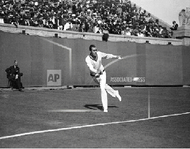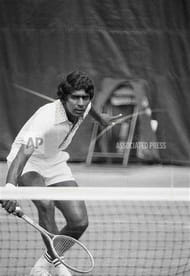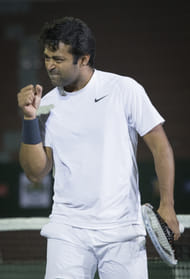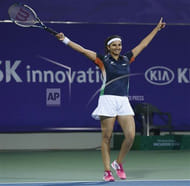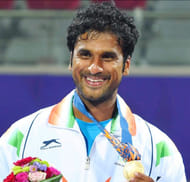The Champions Tennis League may have drawn international attention, but the sport is by far a novel game in India. According to the All India Tennis Association, established in 1920, this is how it took shape :
1880s
In a similar fashion to cricket and football, the game of tennis exchanged hands from the British to the Indians, passed on by British Army and Civilian Officers in the 1880s.
1885
This year saw the start of regular tournaments such as ‘Punjab Lawn Tennis Championship’ in Lahore (then a part of India). The ‘Bengal Lawn Tennis Championship’ in Calcutta was organised in 1887 and The All India Tennis Championship in Allahabad began in 1910.
1905
Indian participation in Wimbledon dates back to the years of the first Championships. B.K. Nehru played in 1905, Sardar Nihal Singh in 1908 and they were later joined by Mohd Saleem, brothers A.H. and A.A. Fayzee and Jagat Mohan Lal, who made it to last 16 stages.
1915
Initially, British players such as T.D. Berrington and L.C. Ogbourne won these championships, but Indians slowly started picking up the game. Saleem of Lahore won the Punjab Championship in 1915 and consecutively thereafter from 1919 to 1926.
1919
Mr. Nagu picked up the prestigious singles crown at the All India Tennis Championship at City’s Gymkhana Club in Allahabad. From then on, the Indians had developed a flair for the sport.
1920
In March of this year, the All India Lawn Tennis Association (AILTA), which changed its name to the All India Tennis Association in the early eighties, was formed in Lahore. The rules and regulations of the game were developed using the constitution of the Lawn Tennis Association of Britain as a basis.
In November, the decision was taken to hold the annual ‘All India National Championships’ in Allahabad and for India to participate in the coveted Davis Cup. The debut Indian team, consisting of S.M. Jacob, Saleem, L.S. Deane and A.A. Fayzee, defeated the seemingly strong French side to reach the semi finals.
1922
Different provinces formed Provincial Associations (now known as State Associations). An Inter Provincial Tournament was organised. Punjab LTA led by Saleem became the first champions. This yearly competition continued until the eve of Second World War in 1939.
1924
In the Paris Olympics, Saleem reached the semi-finals in singles.
1921 – 1929
In the Davis Cup ties during this time, India beat France, Romania, Holland, Belgium. Spain and Greece, amongst others. Indians Saleem, the Fayzee brothers, Cotah Ramaswamy and Krishna Prasad defeated a large number of ranked European players and teams and brought glory to the country.
1930s
India’s repeated success at the Davis Cup and some fine individual performances in Wimbledon earned the respect of leading tennis playing nations and put the country on the world map of the sport.
Teams from Italy, France, Czechoslovakia, England and Yugoslavia visited India. The most notable amongst foreign visitors during this period were the American Bill Tilden, considered by many as the greatest ever in modern tennis, and Henry Cochet, an all time great and one of the famous “Four Musketeers” of France.
1939
Ghouse Mohd, India’s undisputed number one, reached the quarterfinals at Wimbledon.
1949 – 1950
India staged the first Asian International Championship in Kolkata during these years. Dilip Bose emerged as the first Asian Champion and was also seeded at number 15 at Wimbledon in 1950.
1954
Ramanathan Krishnan became the first Asian Junior Wimbledon Champion.
1960s
This was a strong era for Indian tennis. In 1962, Ramanathan Krishnan earned his highest seeding in Wimbledon, at a prestigious number 4.
In the Davis Cup, India repeatedly became the Zonal Champions.
1966
History was made when Ramesh Krishnan, Premjit Lal, S.P. Misra, Jaidip Mukerjea and R.K. Khanna steered India to the Davis Cup finals. Although they lost the Cup, Krishnan and Mukerjea beat John Newcombe and Tony Roche in doubles. Lal and Mukerjea held the national doubles and Asian doubles championships four times each.
1970s
The frontman of the Champions Tennis League, Vijay Amritraj, came on the scene. With teammates Shashi Menon, Jasjit Singh and brother Anand, Amritraj took India to the World Cup finals for the second time in 1974. India did not play South Africa in the Finals due to political reasons.
Amritraj made it to the quarterfinals at the US Open in 1973 and 1981, and Wimbledon in 1973 and 1974. He also defeated the likes of Bjorn Borg, Jimmy Connors, Ivan Lendl, John McEnroe and Newcombe.
1979
Ramesh Krishnan followed in his father’s (Ramanathan) footsteps and became a Junior Wimbledon Champion whilst also winning the junior French title. He was ranked number one junior in the world.
1987
Krishnan was instrumental in lifting India to the Davis Cup finals for the third time by defeating a much more experienced Wally Masur of Australia in straight sets. India lost to Sweden in the finals. He made to the quarterfinals at Wimbledon in 1986 and twice at the US Open. Krishnan retired in 1993.
1990s
Leander Paes became the third Indian to win the junior Wimbledon title as well as the US Open titles in 1990 and 1991.
Paes and Mahesh Bhupathi created history by reaching the doubles finals of all the four Grand Slams in the world and winning the Wimbledon and US Open Doubles titles in 1999. They were ranked as the world number one doubles pair.
2002
Under-14 boys and girls and the under-16 girls’ teams reached within the first eight positions of the world group.
2003
The Indian Davis Cup Team reached the qualifying round of the World group for the fourth consecutive year.
Sania Mirza also burst onto the scene, winning the Wimbledon Championship Girl’s Wimbledon Title, partnering with Alisa Kleybanova of Russia.
2005
In February, Mirza became the first Indian woman to win a WTA title, in Hyderabad.
2006
Paes partnered with Bhupathi and won the gold medal in doubles at the Asian Games. In the 2006 Doha Asian Games, he also won the gold medal alongside Mirza in the mixed doubles. Mirza also won the silver in the Womens Singles Category.
By September, she had achieved three top 10 wins by beating Svetlana Kuznetsova, Martina Hingis and Nadia Petrova.
2009
Mirza became the first Indian woman to win a Grand Slam when she won the Mixed Doubles titles with Bhupathi at the Australian Open.
2010
Mirza won the silver medal in the singles in the 2010 Commonwealth Games and the bronze in the doubles partnering Rushmi Chakravarthi.
She won the bronze medal in the 2010 Asian Games in singles and the silver medal in the doubles partnering Vishnu Vardhan.
2012
Paes and Radek Stepanek won the Australian Open doubles match, after Paes had finished as a runner-up in 1999, 2006 and 2011.
2014
Bright spark of Indian tennis, Saketh Myneni, won two medals at the Asian Games – gold alongside Sania Mirza in mixed doubles and a silver with Sanam Singh in the men’s doubles.
The future
Indian tennis has brightened prospects thanks to initiatives such as the Champions Tennis League, which set its main aim as improving the sport at the crucial grass root level. The sport rides on the successes of talents such as Myneni, Singh, Ramkumar Ramanathan and Sriram Balaji, who have proved their potential at the League and beyond.
Originally published on the Champions Tennis League website here.
